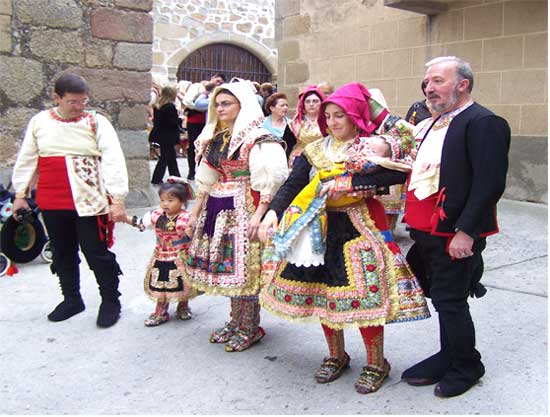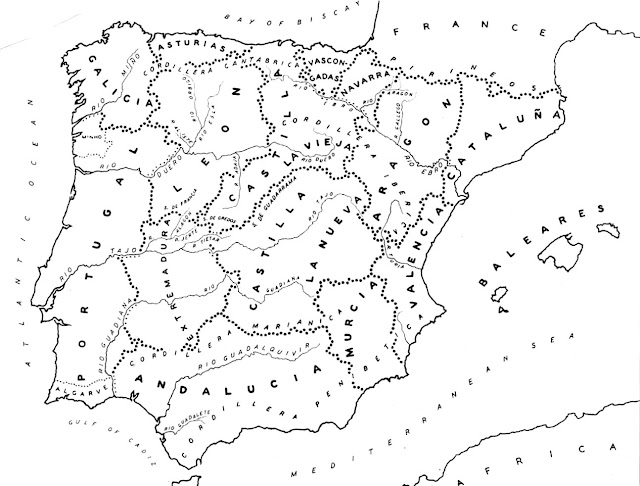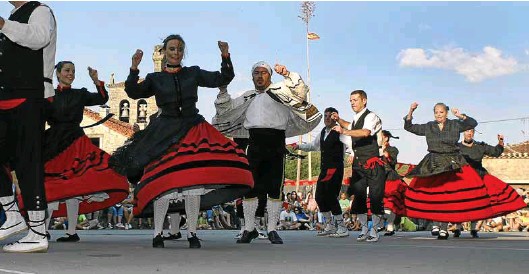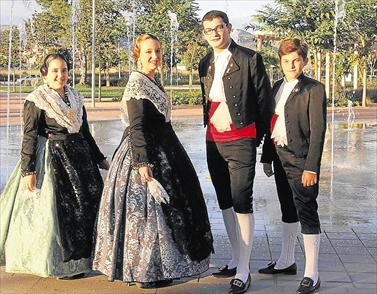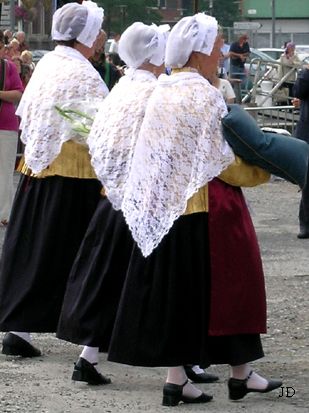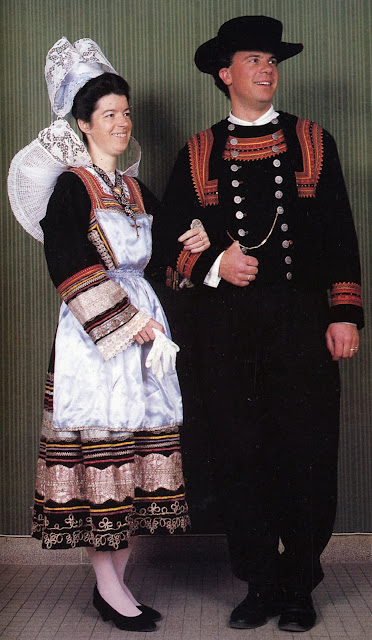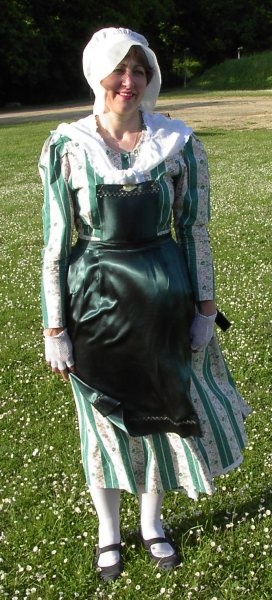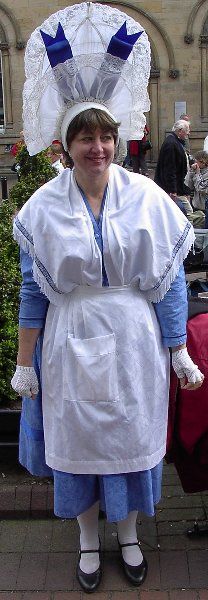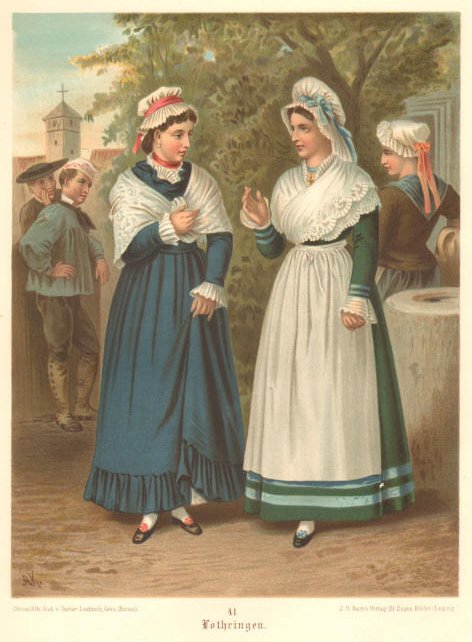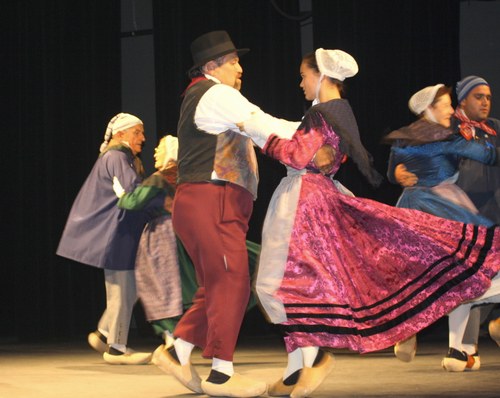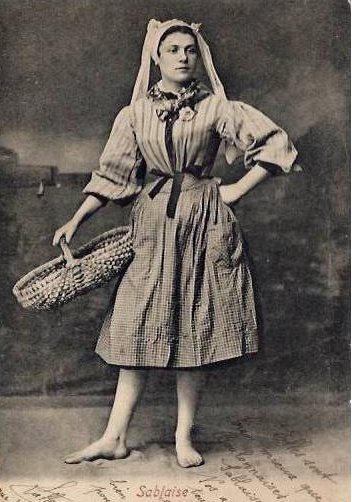This is sometimes worn with natural color leather knickers instead of black wool.
The second is called the 'blue jacket' bunad. It is mostly black, with long pants and a brocade vest in blue and dark red.
Several bunads have been designed for women. The earliest is the 1932 model. This has woven ribbon trim around the bodice and on the hem of the skirt, and an embroidered pocket, but no apron. It is made in a couple of different colors.
The 1956 model is similar, but adds more color options and features a woven apron.
This apron is based on an old photograph from about 1890.
There are two more common versions of the Vestfold woman's bunad. This one is called the brocade bodice bunad. It features an embroidered linen apron, which was copied from one made in the early 19th cent. The embroidery on the pocket is different.
The linen apron is also worn with the other bunad.
The last of the common variants is the velvet bodice bunad. This features a dark apron, and a bodice of a different cut.
All of the above bunads were based on actual found materials. There is another bunad which was designed in the 1930's as a 'free composition'. This is much less commonly seen but features embroidery on the dress, which everyone wants.
Segerbrandt-Bunad
This comes in black, blue, and white, with rosemahl type embroidery. Another example of a remade Gudbrandsdal festbunad.
Akershus
Akershus surrounds Oslo except on the northwest. This is a very densely populated area, including as it does some of the suburbs of Oslo.https://en.wikipedia.org/wiki/Akershus
This is the first province in which we encounter different districts, as can be seen on the map.
Akerdrakt
This can be worn by anyone in the province, but especially those in urban areas near Oslo.
Baerum
There is one Baerum bunad which comes in a variety of colors and choice of aprons. Plaids are common in Folk costumes all over north Europe, they are not restricted to Scotland.
Asker
The above is the festive bunad, there is also a winter bunad.
and a summer bunad.
The men wear embroidered braces under their vests.
Follo
There are currently two costumes from Follo. The Follobunad
This features a linen apron with white openwork embroidery and rococo embroidery on white on the damask skirt, pocket and cap of blue or red.
Follo FestdraktThis is a less expensive alternative now available based on brocades rather than embroidery.
Romerike
The men's bunad.
The Romerike women's festive bunad comes in three colors, blue, green and red.It also comes in three models which vary in type of bodice and embroidery. The three models, believe it or not, are called L40, L46, and L55. The unique Romerike embroidery was taken from an old horse blanket. The apron may be of the same embroidered wool or may be of printed linen.
L40
This features a bodice which is the same color wool as the skirt and pocket. The bodice is cut straight at the waist and seems to be connected with the skirt.
L46
This features a separate bodice with a peplum, the cut of which is copied from an old bodice found in the area. The embroidery, while similar, is distinct if you look carefully, both on the skirt and on the pocket.
Here we see the two side by side.
L55
This model features yet different, although still similar embroidery, and a bodice with a straight cut that is made of damask.
Romerike also has an everyday bunad for both men and women.
There are two municipalities in the north of Romerike which have their own local bunads. Both are of the modified Gudbrandsdal festbunad type.
Hurdal Bunad
Eidsvoll Bunad
Hedmark
This province is found to the north of Akershus, and is one of only two landlocked provinces in Norway. It is very rural still. This is a much larger province than the ones we covered previously.
This area mostly did not wear folk costumes within living memory at the beginning of the folk movement in the early 20th cent., but there were historical records and paintings which showed the costumes. Thus the reconstructions are more historical than in the provinces to the south. There are three traditional districts: Hedmarken, Solør-Odal, and Østerdal. This last is the largest and is shown on the map above as three sub districts, south, north, and east.
Hedmarken
This is a district within Hedmark province.
The man's bunad for Hedmarken
Here are the most recent reconstructed women's bunads for Hedmark. They greatly resemble the common bunads for Solør-Odal and Østerdalen.
Here is the 'traditional' bunad from Hedmarken. In the first image we see, from left to right, the 1935 model, the1955 model, and the 1985 model.
Here is the distinct bunad from Vallset in the south of Hedmarken.
Solør-Odal
This district is in the south of the province of Hedmark, south of Hedmarken. The man's bunad is similar to that worn in Østerdal and Gudbrandsdal. The woman's has a unique bodice with scalloped peplum and fine leather edging. The bunad may be made from various different types of cloth, which is also true of the Østerdal bunad.
This district also has an embroidered bunad in the Gudbrandsdal cut, designed in 1940. Hulda Garborg was part of the committee that designed this bunad.
This is the everyday bunad of the area.
In the east of this district is the municipality of Grue, which includes an area known as Finnskogen, because there was in the 17th century a large group of Finns who settled there. They have to some extent kept their traditions and culture to this day. This drakt is a reconstruction from old photographs.
Østerdal
This is the largest district in Hedmark. According to costumes, it can be divided into south, north and east subregions.
The man's bunad of this area has two forms, the older, which resembles that of Hedmarken and Gudbrandsdal is reminiscent of lumberjack dress, with a plaid wool vest and hat with a bill, and the newer reconstruction which is more urban in character.
Here is an old print which is one of the main sources for the reconstruction of the bunads of this district.
Marie Aaen Bunad
One of the first bunads designed to represent this district was by Marie Aaens, from Tynset in the north. She won a contest with this design in 1947. It definitely is quite attractive, and she paid attention to the traditions of the area, note the bodice with peplum and the plaid apron.compare to the image above. She also added some very attractive embroidery, taken from rosemahling [folk painting] of the area. It remains popular today. The bodice and skirt may be in black with green trim or in green with black trim.
Another bunad to be used over all of Østerdal is less well known but has a very similar history.This one was designed by Ruth Arnestad Lødrup.
Lødrup Bunad
South Østerdal
Østerdal is the largest district in this province, and has several divisions, and bunads for each.
This is the bunad for the south part, shown on the map above. Note the similarity to the reconstructed Hedmarken bunad above. Since this is based on multiple museum pieces, there are a variety of possible fabrics for the bunad. One can wear a shirt and bodice, or a jacket. The most commonly used apron has a woven in leaf design. The blouses do not have cuffs or collars, but do feature white openwork.
South Østerdaln also has an everyday bunad.
North Østerdal
This is similar to the south Østerdal bunad, but has a plaid apron, an embroidered pocket and differs in other small details. The men's bunad is the same
There are other bunads and drakts for specific areas in Østerdal.
Here is one from the eastern part.
Trysil Bunad
The rest of these are all from specific areas in the north of Østerdal. The original costume traditions lasted longest in the north.Each of these three areas have two bunads.
Alvdal Bunad
Alvdal Bunad with embroidery
Folldal Bunad
Folldal Bunad with plaid skirt.
Kvikne Bunad
Kvikne Bunad with embroidery, or Kvikne Church Bunad
This has exceptionally nice embroidery.
It looks like my article on Norway will turn into a series of four articles.
This is enough for one.
Thank you for reading, I hope that you have found this interesting and informative.
email
rkozakand@aol.com
Source Material:
Bjorn Sverre hol Haugen, 'Norsk Bunadleksikon' Oslo, 2009Kjersti Skavhaug et al, 'Norwegian Bunads', Oslo, 1991Heidi Fossnes, 'Norges Bunader og Samiske Folkedrakter', Oslo, 1993Ellen Scheel et al, 'Bunad-Brodering', Oslo, 1997






































































































































